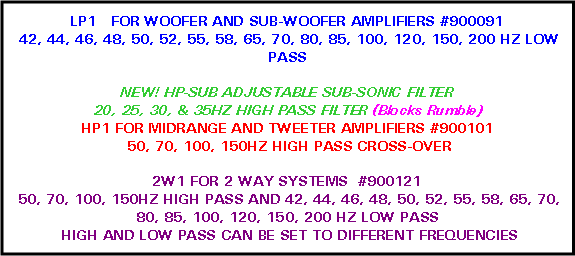Solid review, Amir! Still have the original shipping cartons, doc & NLA (Walnut) from 1976. New surrounds & connected to the Advent 300 receiver. Under-powered, but haven't yet found an amp to use the receiver as a preamp.
For those who were Advent fans back in the day, what speaker is your go-to today?
THIS IS NOW A SECONDARY SYSTEM FOR ME (& has been for a long, long time): Since my ADVENT 300 was new, I used these Frazier speakers (& still do). My somewhat later setup is this (which I still use today): Both left & right channels going into a (larger of the 2 styles built) black 12 inch Radio Shack cabinet (through it's stock L & R crossover) with a Pioneer 93 DB at 2.83 Volt (don't remember the model) dual 4 ohm voice coil AUTO SOUND COMPETITION speaker that send the left & right signals to vintage (the same era):
(This is a copy of the CBS Labs test done in June 1975)
Frazier Model F8-4SH-A (Monte Carlo IV A or Super Monte Carlo),
a compact full -range loudspeaker system in oiled -walnut enclosure. Dimensions: 10 1/2 by 19 inches (front -may be used horizontally or vertically), 11 3/4 inches deep. (back then) Price: under $100 (may vary locally).
Warranty: five years parts and labor, shipping paid one way.
Manufacturer: Frazier, Inc., P.O. Box 34216, Dallas, Tex. 75234.
Comment: This is by far the smallest and least expensive speaker we have ever tested from Frazier -though it is not, in fact, the most unassuming the company has offered in a finished system. (The minute, one-way, $50 Super Midget is.) Frazier's reputation rests on an excellent series of floor -standing models plus a line of equipment for use in commercial sound reinforcement. What kind of a mini-speaker would it make, we wondered. There were some surprises in the answers the Super
Monte Carlo gave us. First of all, we had assumed from the small enclosure size that here would be one Frazier system
of relatively low efficiency. No way. CBS Labs found that the Monte Carlo could produce the standard 94 -dB test level with only 1 watt of input power, confirming the manufacturer's claim that in average rooms only 1/2 watt will be needed. All right, so it's not power-hungry; but can it take power with equanimity? The lab hit 40 watts -for an output of 108 dB -before encountering excessive distortion, indicating excellent dynamic range as well as good power handling. And in pulse tests the speaker handled over 130 watts (average) before distorting excessively. So any amplifier rated at between, say, 5 and 40 watts should be an excellent match, with the choice at the bottom end of the range dictated both by how much reserve power you want and by your patience in hunting for a low -power amp of sufficiently high quality.
From the foregoing description it should come as no surprise that the Monte Carlo employs a ducted port for relatively high efficiency in a small enclosure without drastic sacrifice of bass. The port actually is a slot whose operation is described by Frazier as a modified Helmholtz resonator. The system uses an 8 -inch woofer and a piezoelectric horn tweeter. There is no electrical crossover network; the natural response characteristics of the two drivers are matched to deliver an effective acoustic crossover point of about 4 kHz. (The presence of the piezoelectric tweeter is specified by the "SH"-for "super horn" -in the model number and "Super" in the model name.)
Presumably because of the loading provided by the port slot, the system's impedance curve shows multiple peaks in the bass. The rating point (at the next minimum -about 350 Hz) was measured by CBS Labs at 9.5 ohms, confirming Frazier's 8 -ohm listing. Since the 9.5 -ohm figure is the lowest measured at any frequency (average across the audible band is in the neighborhood of 16 ohms, though values throughout the midrange are lower than that), there should be no problem in paralleling these speakers with any other 8 -ohm model off a transistorized amplifier. (This is particularly important if you are contemplating them as extension speakers.) Despite its small size the Super Monte Carlo reaches to below 40 Hz. Of course you can't have everything, and doubling is fairly high in the extreme bass region. That is to say that in small enclosures a tradeoff must be made.
Frazier's $90 Super Monte Carlo
Frazier Monte Carlo Harmonic Distortion'
Output Frequency
Level 80 Hz 300 Hz
(dB) % 2nd % 3rd % 2nd % 3rd
70 0.6 1.3 0.65 0.75
75 0.7 1.3 0.65 0.80
80 0.9 0.9 0.65 0.88
85 1.2 1.5 0.65 0.92
90 2.1 2.3 0.70 1.0
95 4.3 2.3 0.70 1.1
100 9.0 6.0 0.70 1.3
105 0.80 1.9
108 0.90 3.0
Distortion data are taken on all tested speakers until distortion exceeds the
10% level or the speaker produces the spurious output known as buzzing,
whichever occurs first.
JUNE 1975 47
AmericanRadioHistory.Com
I sometimes run my pre-outs into a Harrison LABS PFMOD (analog) Parametric Electronic SUB X-OVER
into a bi-amped configuration of NAD 2100's or a tri-amped configuration of triplet NAD 2200's (both my ADVENT 300 & one of my NAD 2200 triplets can be found here reviewed by AMIRM). Good luck. You may PM me if you have any questions.



